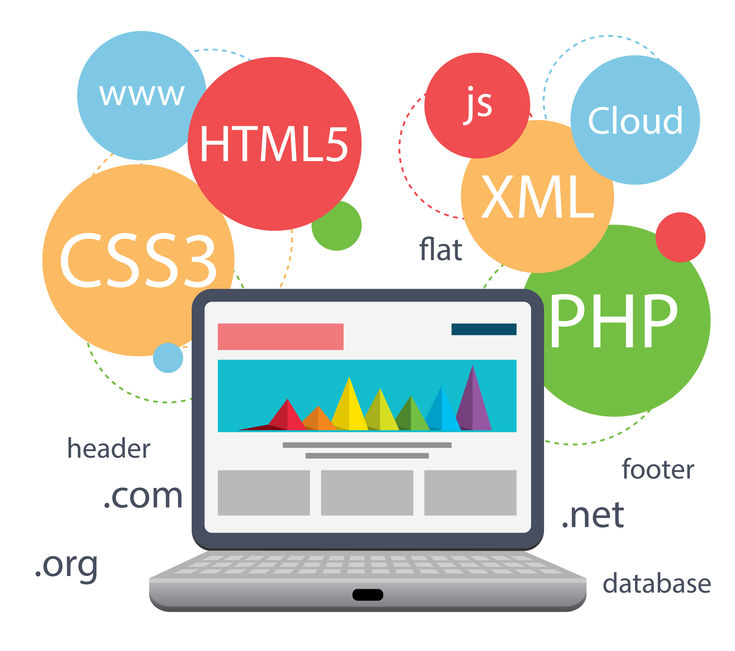Learn the basics of developing a website using HTML5 and CSS3. The student will learn to use HTML5 and CSS3 to access content on various devices. Students will learn to use HTML5 and CSS3 to enhance the website by being able to add special effects to the images, text, graphics, color, and text, and more.
Learning Objectives
Upon successful completion of this course, students will be able to:
- design and develop a Website
- Use Cascade Style Sheet (CSS3) to customize a web page
- Develop interactive web pages
- Embed picture and video on a page
Course Outline
- Introduction to HTML
- Naming Your Document
- HTML4 vs HTML5
- Features Of HTML5
- Removed Elements
- New HTML5 Tags
- Essential HTML Tags
- <META>, <TITLE>, <BODY> Tag
- HTML Tags related to Text
- Header Tag
- Paragraph and Text Breaks
- Cascading Style Sheets (CSS)
- Rules for CSS, 3 Ways to Use CSS
- Using CSS as Inline Style
- Internal Style Sheet
- External Style Sheet
- Using CSS file for Styling
- Using CSS to customize BODY Tag
- Setting the background color of the web page.
- Setting the background image of the web page.
- Setting the text color for the page.
- Customizing Text Color
- Using Header Tag
- Formatting Text using CSS
- Customizing Text Alignment
- Using CSS to ALIGN Text
- Displaying a List
- Using CSS to Display Customized List
- Using Bullet Tag, Adding Images
- Using IMG Tag
- Modifying the Size of an Images
- Center Align the Image
- Using Center Tag
- Right Aligning the Image
- Left Aligning the Image
- Adding YouTube in an App Page
- Adding Hyperlink
- Adding Sound to the Web Page
- Play an audio file in HTML5
- Adding Background Sound
- Introduction to HTML Tables
- Using Table Tag
- Attributes of Table Tag
- Using Width attribute
- Formatting Cells
- Using Cell Spacing
- Using Span Attribute
- Using Cell Alignment
- Using Align Attribute
- Adding Rows
- Modifying Table Header
- Using Table Header Tag
- Customizing List
- Customizing Border
- Introduction to HTML Form
- Input, Text Fields
- Creating a Simple Form
- Using Radio buttons
- Using Checkbox
- Using the Submit button
- Final Hands-on Project
Assumption
The student is familiar with basic computer usage and is committed to working independently in their own time on a project assigned to them.
Modes of Learning
Live Online Interactive Training Sessions
Students will attend online classes conducted by a panel of our expert teachers and will have the opportunity to interact live with the instructor. Students will meet the instructor live online at a scheduled time once a week for 8 weeks. They have the option to signup for a group or private lesson.
Group Lesson: We maintain 1:5 teacher to student ratio ensuring every student gets individual attention.
Private Lesson: For an additional fee, the student can signup for a one-on-one private online lesson.
We pride ourselves in paying attention to every detail and intellectual needs of the students and ensure that the student’s training needs are met and the knowledge about the subject is delivered efficiently. Students will be assigned an account to access the courseware and instructor (via email) for a period of 12 months so they can also continue to study on their own, work on assigned projects and prepare for the final assessment even after the live online course is over.
After successful submission of the project work and passing assessments, a “Certificate of Completion” will be awarded by NRCLC validating the skill set acquired during the course. It is mandatory to pass all the assessments with at least 70% to obtain a “Certification of Completion”.
Modules
The course consists of 8 modules. The workload of each module varies and consists of a combination of the following:
Lecture: The Lecture consists of notes that can be used by students as reference material. Each module consists of at least one online lecture note with examples applicable to real-life scenarios. To keep the students up-to-date with the latest information, the lecture notes may consist of hyperlinks to current resources, such as an article, a book, or a website.
Hands-on Activity: The hands-on activities help students apply the concepts learned during the lecture. Each module consists of programming activities and exercises.
Quiz: The quiz allows the student to further validate their learning. Students get unlimited attempts to pass the quiz with a minimum score of 70%.
Mini-Project: Projects help students apply the concepts learned through the lecture and apply them to build an application. All the mini projects are to be submitted via email before the end of the course.
Module Completion: To complete each module, the student must follow the instructions listed in the lecture notes.
Final Exam: At the end of the course, the student can take the final exam. The student must score 70% or more to receive a certificate of completion.
Technical Requirements
A computer with Internet access.
Audience
This is suitable for beginners who are interested in developing a program in Java or becoming a game programmer – one of the hottest career fields today. This course is also good for high school students who are planning to take AP Computer Science.
JOIN THE COURSE




